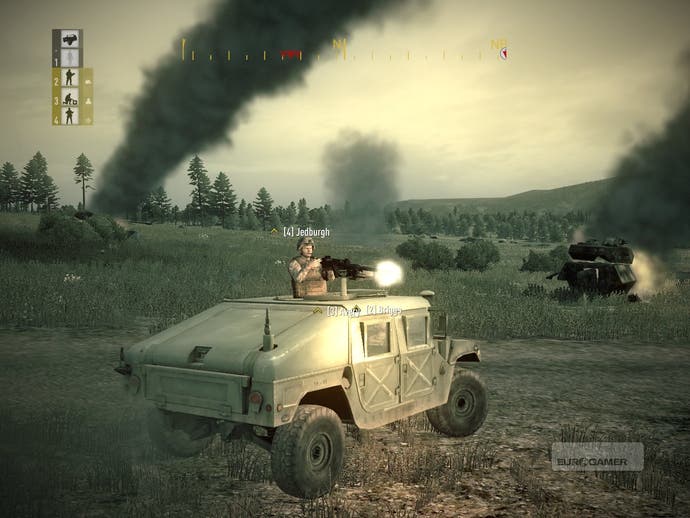Operation Flashpoint: Dragon Rising
Red mist, purple heart.
The Eurogamer Black Hawk that carried Sergeant Parkin into Skira didn't come straight home. It crossed the densely-forested console/PC border and dropped off another eager soldier-simmer before returning to base. I was that simmer and this is what I learnt from my time in-country.
The first emotion Dragon Rising stirred in me? Disappointment. Launching into the 11-mission campaign fresh from a bout of ArmA II, the flat lighting, washed-out sepia tones and low-res terrain textures of the Skiran landscape had me checking I hadn't minimised the graphics settings by mistake. Later outings in sunnier/moonier conditions show off the vast seamless battlespace far better, but still, it's hard to shake the feeling that Codemasters has lost the beauty contest to Bohemia Interactive.
If we're going to be petty and keep score, the British devs equalise with their elegant radial-menu based GUI. A control system that allows you to order squad-mates about, altering everything from their stances to their rules of engagement to the sides they part their hair, is never going to be idiot-proof, but Dragon Rising's logically-layered menus, accessed through the oh-so-convenient WSAD keys, come mighty close.
Picking victors starts getting complicated when you venture into core areas like infantry combat. The newcomer might not let you lean - a ludicrous omission - and may, when a shooter is close to cover, occasionally block outgoing lead for no apparent reason, but there's no denying the plausibility of its atmospheric, adrenalin-steeped skirmishes. Mud and blood lens-spatter are extremely well-used as are the ZZZIPs, PHWIPS, KRAKS and F*CK!s that pepper the spontaneous soundtrack. Most importantly, the ballistic modelling has an air of grim authority to it.
Do slugs penetrate wooden fences and shack walls? Sadly, I think not. Do projectiles projected over long distances obey gravity? Most definitely. That trademark Operation Flashpoint experience, sniping a faraway foe by aiming several metres over his head, is certainly feasible in the sequel. That other trademark Operation Flashpoint experience - dropping like a sack of spuds after taking a single bullet to a vital organ - also re-appears.

Such sudden demises could be maddening. The fact they aren't says a lot about OFDR's extremely well-judged lethality levels. You'd have to be remarkably unlucky or remarkably stupid to get insta-killed on a regular basis, but the threat of it gives every ballsy advance and nervous house-clearing a palpable piquancy. Most wounds will finish you only if you fail to treat them before the bleed-out timer runs down. If you're incapacitated, aid must be administered by a human or CPU-controlled team-mate. Some of the tensest moments in the game come when you're laying in a pool of blood waiting for a medic to respond to your plaintive cries.
The PLA also play their part in keeping the gunplay credible. Like all the best artificial adversaries, you're never quite sure how they will react to danger. Some hit the dirt and start crawling when the angry lead bees arrive, others dash for cover, hurl smoke grenades, dart behind trees, or commence aggressive flanking manoeuvres. Just about the only behaviour they don't appear to have mastered is surrendering. Oh, that and post-mortem persistence.







